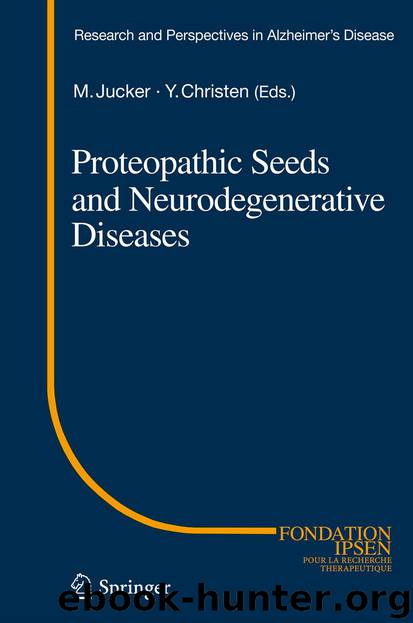Proteopathic Seeds and Neurodegenerative Diseases by Mathias Jucker & Yves Christen

Author:Mathias Jucker & Yves Christen
Language: eng
Format: epub
Publisher: Springer Berlin Heidelberg, Berlin, Heidelberg
Misfolded Aβ Aggregates and AD
AD is the most important PMD due to its prevalence in the aged population. This disease, described for the first time by Alois Alzheimer in 1907, is characterized by a progressive and irreversible brain degeneration that leads to gradual memory loss and decline of cognition, including changes in personality. These abnormalities are induced by synaptic dysfunction and neuronal loss. AD is the most common type of dementia in the elderly, accounting for 60–80 % of all dementia cases, which also include frontotemporal dementia, dementia with Lewy bodies and vascular dementia, among others (Ballard et al. 2011). Currently, more than 26 million people worldwide suffer from AD (Brookmeyer et al. 2007) and about 10 % of individuals over the age of 65 have some degree of AD; the frequency increases to nearly 50 % by the age of 85. Since the proportion of elderly people is currently increasing, and the risk of developing AD escalates exponentially with age, it is predicted that the prevalence of this dementia will double by 2050 (Brayne 2007). At this moment, there are no effective methods to treat or diagnose AD, which constitutes a major problem for public health.
As we have previously noted, the primary pathological hallmark in the AD brain is the presence of amyloid plaques and neurofibrillary tangles (NFT), which are composed of extracellular deposition of misfolded Aβ peptides and intracellular hyperphosphorylated tau, respectively (Glenner and Wong 1984; Grundke-Iqbal et al. 1986). Senile plaques are amyloidogenic deposits with a dense central core, surrounded by dystrophic neurites and a severe inflammatory reaction. NFTs are abnormal, filamentous inclusions found in neuron somata and composed principally of abnormally folded tau protein. Tau, a microtubule-associated protein, forms paired helical filaments upon hyperphosphorylation, which leads to impaired axonal transport and, eventually, cell death (Brandt et al. 2005; Vossel et al. 2010). Other AD lesions include loss of synaptic connection, neuronal death, cerebral amyloid angiopathy and oxidative stress (Serrano-Pozo et al. 2011). Inflammation in the AD brain is characterized by activated microglia and reactive astrocytes that are associated with Aβ deposits and up-regulation of many mediators of the inflammatory response (McGeer and McGeer 2007). The medial temporal lobe areas, e.g., hippocampus and entorhinal cortex, are the first regions affected by the pathological features of AD (Braak and Braak 1991).
A widely accepted model explaining brain degeneration leading to the clinical signs of AD is the amyloid cascade hypothesis. This model was proposed 20 years ago, shortly after the initial genetic discoveries of APP mutations leading to familial AD (Hardy 1992). The model posits that abnormal aggregation of Aβ and its deposition in the brain parenchyma are the decisive steps that trigger AD pathology. NFTs, cell loss, inflammation, and dementia are the result of Aβ pathology. However, several reports suggest that there is not a positive correlation between extracellular fibrillar amyloid burden and cognitive impairment or dementia (Arriagada et al. 1992; Price et al. 2009). To accommodate for recent findings, the amyloid hypothesis has been modified to propose
Download
This site does not store any files on its server. We only index and link to content provided by other sites. Please contact the content providers to delete copyright contents if any and email us, we'll remove relevant links or contents immediately.
Men In Love by Nancy Friday(5155)
Everything Happens for a Reason by Kate Bowler(4678)
The Immortal Life of Henrietta Lacks by Rebecca Skloot(4525)
Why We Sleep by Matthew Walker(4360)
The Sports Rules Book by Human Kinetics(4294)
Not a Diet Book by James Smith(3336)
The Emperor of All Maladies: A Biography of Cancer by Siddhartha Mukherjee(3066)
Sapiens and Homo Deus by Yuval Noah Harari(2987)
Day by Elie Wiesel(2720)
Angels in America by Tony Kushner(2596)
A Burst of Light by Audre Lorde(2546)
Endless Forms Most Beautiful by Sean B. Carroll(2431)
Hashimoto's Protocol by Izabella Wentz PharmD(2331)
Dirty Genes by Ben Lynch(2272)
Reservoir 13 by Jon McGregor(2242)
Wonder by R J Palacio(2139)
And the Band Played On by Randy Shilts(2129)
The Immune System Recovery Plan by Susan Blum(2029)
Stretching to Stay Young by Jessica Matthews(2001)
